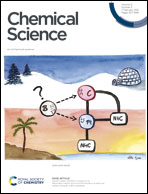Tri-insertion with dearomatization of terminal arylalkynes using a carborane based frustrated Lewis pair template†
Abstract
Intramolecular vicinal Frustrated Lewis Pairs (FLPs) have played a significant role in the activation of small molecules, and their stabilities and reactivities are found to strongly depend on the nature of the bridging units. This work reports a new carborane based FLP, 1-PPh2-2-BPh2-1,2-C2B10H10 (2), which reacts with an equimolar amount of p-R2NC6H4C![[triple bond, length as m-dash]](https://www.rsc.org/images/entities/char_e002.gif) CH (R = Me, Et, Ph) at room temperature to give C
CH (R = Me, Et, Ph) at room temperature to give C![[triple bond, length as m-dash]](https://www.rsc.org/images/entities/char_e002.gif) C triple bond addition products 1,2-[PPh2C(R2NC6H4)
C triple bond addition products 1,2-[PPh2C(R2NC6H4)![[double bond, length as m-dash]](https://www.rsc.org/images/entities/char_e001.gif) CHBPh2]-1,2-C2B10H10 (3) in high yields. Compounds 3 react further with two equiv. of p-R2NC6H4C
CHBPh2]-1,2-C2B10H10 (3) in high yields. Compounds 3 react further with two equiv. of p-R2NC6H4C![[triple bond, length as m-dash]](https://www.rsc.org/images/entities/char_e002.gif) CH (R = Me, Et) at 60–70 °C to give unprecedented stereoselective tri-insertion products, 3,3a,6,6a-tetrahydronaphtho[1,8a-b]borole tricycles (4), in which one of the aryl rings from arylacetylene moieties has been dearomatized with the formation of four stereocenters including one quaternary carbon center. It is noted that the phosphine unit functions as a catalyst during the reactions. After trapping and structural characterization of a key intermediate, a reaction mechanism is proposed, involving sequential alkyne insertion and 1,2-boryl migration.
CH (R = Me, Et) at 60–70 °C to give unprecedented stereoselective tri-insertion products, 3,3a,6,6a-tetrahydronaphtho[1,8a-b]borole tricycles (4), in which one of the aryl rings from arylacetylene moieties has been dearomatized with the formation of four stereocenters including one quaternary carbon center. It is noted that the phosphine unit functions as a catalyst during the reactions. After trapping and structural characterization of a key intermediate, a reaction mechanism is proposed, involving sequential alkyne insertion and 1,2-boryl migration.



 Please wait while we load your content...
Please wait while we load your content...